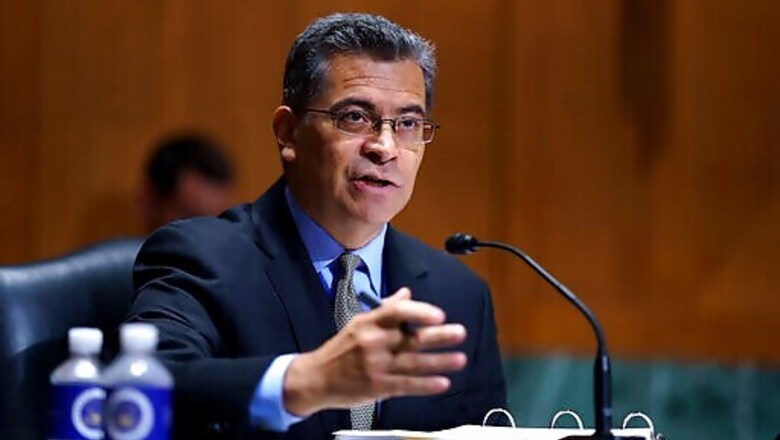
views
WASHINGTON: The Biden administration on Thursday began putting in place consumer protections against surprise medical bills enacted in bipartisan legislation signed last year by former President Donald Trump.
Regulations jointly issued by four federal agencies spell out protections for insured patients against surprise billing in medical emergencies, and unexpected charges from out-of-network doctors at an in-network facility. Out-of-network clinicians and service providers would also be barred from billing patients for the difference between their charges and what insurance paid.
Surprise medical bills are a common and frustrating problem for people with health insurance, even if they thought they were protected. Charges that can run from hundreds to tens of thousands of dollars come from doctors and hospitals outside the network of a patients health insurance plan. Its estimated that about 1 in 5 emergency visits and 1 in 6 inpatient admissions triggers a surprise bill.
Thursdays action signaled that the Biden administration is committed to having the new protections in place for consumers by Jan. 1, as the law requires. Work continues on another major piece of the new framework, a process to resolve billing disputes between insurers and medical providers without dragging patients into the middle.
It’s a rare demonstration of bipartisanship on health care, one of the most politically polarized issues of the past decade, as Republicans repeatedly and unsuccessfully tried to repeal the Obama-era Affordable Care Act.
It’s about getting good health care at a good price for all Americans it’s a bipartisan effort, said Health and Human Services Secretary Xavier Becerra, whose department is working on the issue with Treasury, Labor and the federal government’s personnel agency. You will no longer be stuck in the middle of a payments dispute because you were blindsided by a charge you weren’t expecting.
Consumer advocates, insurers and medical and hospital associations will pore over the complicated fine print of the Biden administration’s rule. Arcane definitions pertaining to such issues as pricing can translate to millions of dollars of economic impact. It may take days to identify all the winners and losers.
They are clearly pulling out the stops to get this implemented in a timely manner, said Karen Pollitz, a health insurance expert with the nonpartisan Kaiser Family Foundation. We know this has been a problem that people put at the top of their list of worries.
Pollitz said it could take until well into next year to see how the new system works in real life. Currently millions of surprise bills are sent every year. Even if 90% of them are handled perfectly the first year, you could still have hundreds of thousands that go through to the patient, she said.
Although many states have passed curbs on surprise billing, federal action was needed to protect patients covered by large employer plans regulated at the national level. The Biden administration is allowing 60 days for public comment on its rule.
The surprise billing law passed by Congress last year takes patients and their families out of the financial equation by limiting what they can be billed for out-of-network services to a fee thats based on in-network charges. That amount gets counted toward their in-network annual deductible.
Insurers and medical services providers would work out billing disputes between themselves or submit them to an independent dispute resolution system, yet to be set up.
The central provisions of the legislation include:
Holding patients harmless from surprise bills resulting from emergency medical care. Protections apply if the patient is seen at an out-of-network facility, or if they are treated by an out-of-network clinician at an in-network hospital. In either case, the patient can only be billed based on their plans in-network rate.
Protecting patients admitted to an in-network hospital for a planned procedure when an out-of-network clinician gets involved and submits. This can happen when a surgeon is called in to assist in the operating room, or if the anesthesiologist on duty is not part of the patients plan.
Requiring out-of-network service providers to give patients 72-hour notice of their estimated charges. Patients would have to agree to receive out-of-network care for the hospital or doctor to then bill them. This exception is not available for emergency departments or certain kinds of medical professionals, such as radiologists.
Barring air ambulance services from sending patients surprise bills for more than the in-network cost sharing amount.
According to the Kaiser Foundation, 18% of emergency visits lead to at least one out-of-network charge for people covered by large employers, as do 16% of in-network inpatient admissions. New York and Texas have among the highest rates.
The problem is a direct of result of high health care costs. To try to keep premiums in check, insurers set up networks of hospitals and doctors who agree in advance on payment levels. But some high-demand clinicians, such as emergency room doctors and anesthesiologists, have an incentive to stay out of at least some networks, to maximize their earnings. That dynamic has grown more complicated as profit-seeking investors buy out medical practices that have greater billing leverage.
Public programs like Medicare and Medicaid prohibit or restrict such billing practices.
Disclaimer: This post has been auto-published from an agency feed without any modifications to the text and has not been reviewed by an editor
Read all the Latest News, Breaking News and Coronavirus News here.















Comments
0 comment